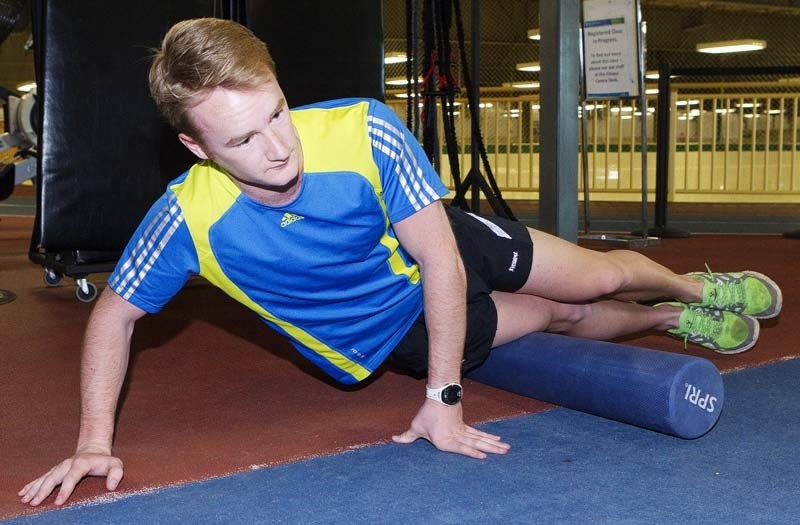Kiel Klauwers has been running for the past three years and has competed in two triathlons.
Two summers ago he noticed pain striking the outside of his knee.
“I knew I had an issue because it was affecting my running. I couldn’t go for more than five to 10 minutes at a time before I had to stop due to the pain,” said the 22-year-old physical education student at the University of Alberta.
After a visit to the physiotherapist, Klauwers found out he had iliotibial band (IT band) syndrome, the second most common injury among runners. Overuse of the large band of connective tissue that stretches from the hip to just below the knee at the shin, can lead to tightening and friction of the tissue across the bone.
When the band becomes inflamed, runners – both new and seasoned – may notice pain and swelling at the outside of their knee joint and a snapping or popping sensation when the knee is bent. It can also trigger pain in the hip or cause aching in the quadriceps.
Hikers and cyclists may also be afflicted with IT band syndrome, the main causes of overuse are muscle imbalances and poor training habits.
“When looking at running gait – how they’re running – generally someone who is more of a heel striker … will end up having some IT band issues,” said Graham Glennie, physiotherapist at Dynamic Sports Physiotherapy in St. Albert.
He added runners using their heel as their first point of contact on the ground will engage the IT band more frequently than other muscle groups, thus causing it to strain. Runners should pay close attention to their form and use their mid-foot to strike the ground in order to minimize the amount of impact travelling up to the knee. Research has also connected step width and the degree by which the knee bends, with IT band strain.
Glennie recommended endurance runners strengthen their hip, glute and core muscles, since weakening of these muscle groups puts more work on the IT band.
Findings from a study done by researchers from the University of Calgary in 2011, confirmed the importance of strong hip muscles. After six weeks of rehabilitation that involved stretching, hip-strengthening and foam roller self-massage, all nine participants showed increased hip muscle strength and were able to get back into the sport, pain-free.
Since the length or flexibility of the IT band showed no changes, results indicated hip muscles may play a larger role in IT band syndrome than previously thought.
Far from a death sentence, Glennie said patients typically rehabilitate an IT band injury in four to six weeks.
“For (Kyle), we made sure he was still running, but not going past the point where he was injuring himself.” Glennie added the injury could haunt athletes, especially when they don’t follow the recommended “homework” of stretches, foam rolling, cool-downs, strengthening exercises and cross-training.
Chronic flare-ups, admitted Klauwers, is one of the most frustrating parts of being injured.
“It’s one of those nagging injuries. It goes away and comes back, especially if you neglect treating it on your own.”
IT band exercises for runners
• Hip abductor strengthening: Standing beside the resistance band, loop the band around ankle of the outside foot. Keeping hips level and trunk upright, lift the active leg so the foot is hovering off the floor. Keeping the foot in a neutral position, proceed to move the leg to the side. Raise leg to a range of motion that does not allow any compensation in the hip. Slowly return the leg back to starting position and repeat. 2 seconds out, 2 seconds in, in tempo.<br />• Hip gluteus medius strengthening: Facing the resistance band, loop the band around one ankle. Keeping hips facing forward, lift the active leg so the foot is hovering off the floor. Keeping the foot in a neutral position proceed to move the leg back on a 45 degree angle with a straight knee and upright posture. Slowly return the leg back to starting position and repeat.<br />2 seconds back, 2 seconds forward<br />• Hip extensor strengthening: Facing the resistance band, loop the band around one ankle. Keeping hips facing forward, lift the active leg so the foot is hovering off the floor. Keeping the foot in a neutral position proceed to move the leg straight back with a straight knee and upright posture. Slowly return the leg back to starting position and repeat. 2 seconds back, 2 seconds forward.<br />• IT band foam roller: Lying on side with foam roller positioned just above the knee, stack the hips and place the foot of the top leg on the ground. Keep bottom leg straight with the foot in a neutral position. Roll slowly until the roller is positioned at hip.Switch legs and repeat. Perform 1-2 times per<br />day.<br />• IT band stretch: Standing tall (shoulders over hips) and feet shoulder width apart. Cross left foot behind right foot. The left leg will be the active leg in the exercise. Lean towards the right pushing the hip outwards to the left. Hold position for 20-30 seconds. Switch legs and repeat for 3 sets. Perform 1-2 times per day.




